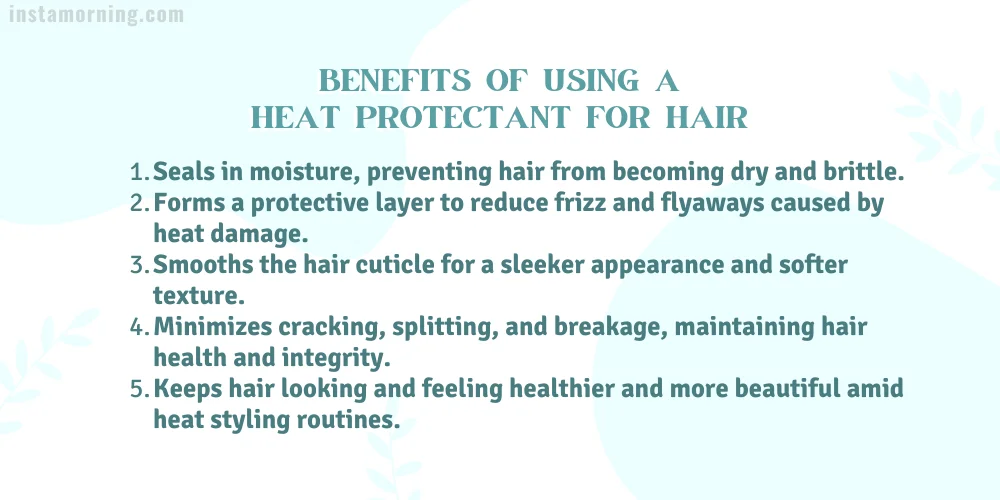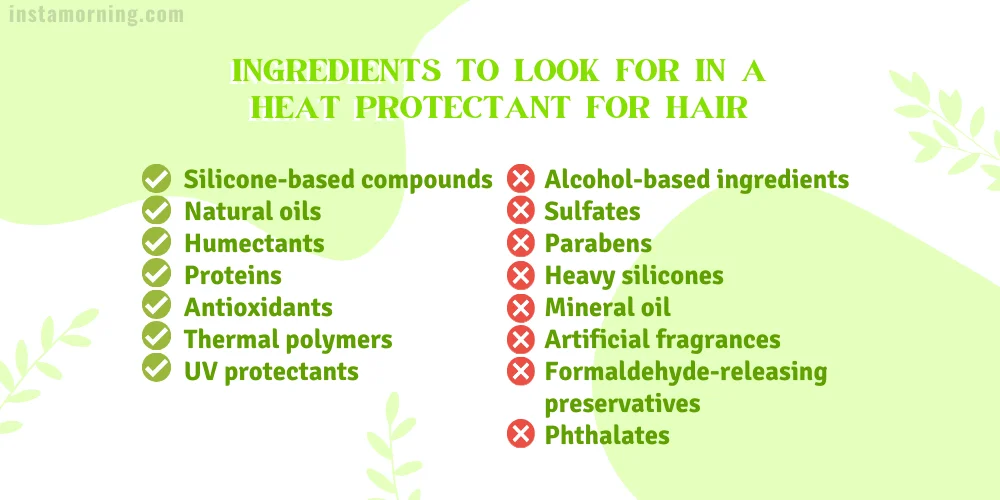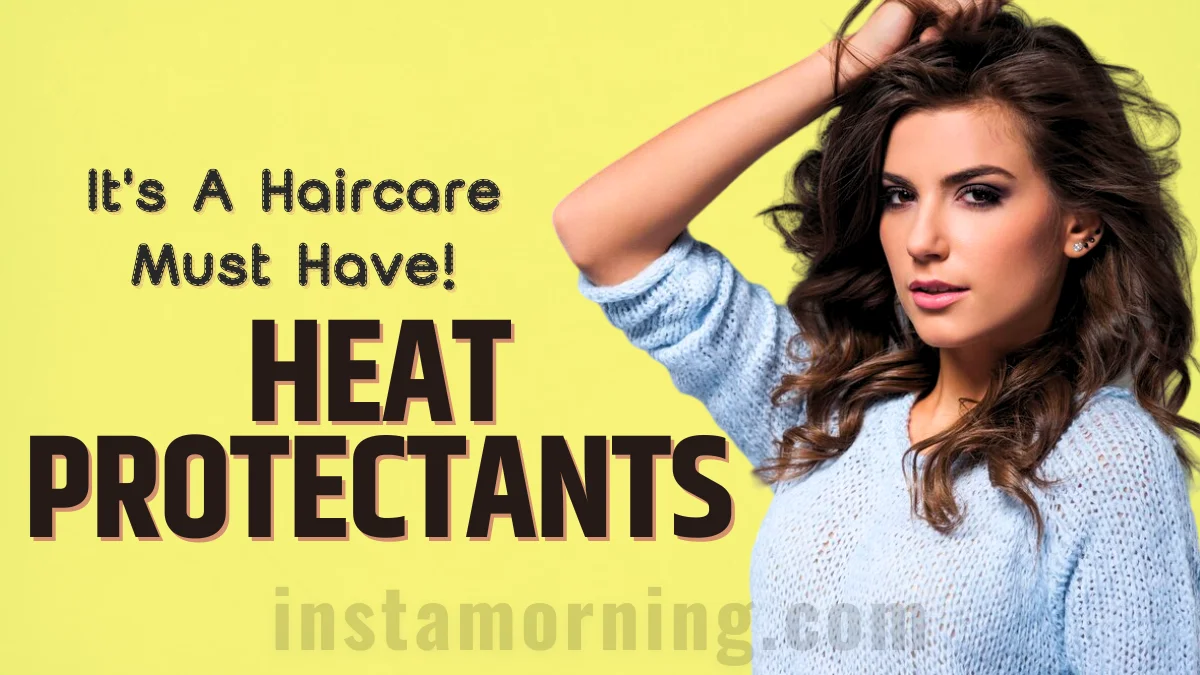Heatproof Your Hair: The Ultimate Guide to Choosing the Right Heat Protectant
If you frequently use heat-styling tools like blow dryers, curling irons, or straighteners, a heat protectant for hair is highly recommended.
These products form a barrier between your hair and the heat, reducing the damage caused by high temperatures. Additionally, they help seal in moisture, prevent frizz, and smooth the hair cuticle, making your hair look smoother and softer.
If you rarely use heat styling tools or have naturally resilient hair that isn’t prone to damage, you may not need hair protectants as much. However, it’s still beneficial to use them occasionally to provide extra protection, especially if you do use heat styling on occasion.
Ultimately, whether you need hair protectants depends on your hair type, styling habits, and the level of protection you desire to maintain healthy, vibrant hair. Let us discuss Hair Heat Protectants in detail.
What are Heat Protectants?
Heat protectants are hair products designed to reduce damage caused by heat styling tools such as blow dryers, curling irons, and straightening irons. They function by creating a barrier between the heat source and the hair, which helps to seal in moisture and prevent frizz.
Additionally, heat protectants work to smooth the hair cuticle, resulting in smoother, softer-looking hair. These products typically come in the form of sprays, creams, or serums that are applied to either damp or dry hair before using heat-styling tools.
They often contain ingredients like humectants to retain moisture and block frizz, amino acids to strengthen hair and provide antioxidants, and natural oils and extracts to protect and seal the hair cuticle. While some heat protectants may contain silicones and water-based polymers, which can leave a film on certain hair types, others opt for formulas without these ingredients.
Ultimately, heat protectants serve as a preventative measure against heat damage, though they do not eliminate the risk, particularly with frequent styling.
Also Read — These Are The Best Heat Protectant For Hair
Why is Heat Protectant Important?
Heat protectant is important because it helps to minimize the damage that heat styling tools can inflict on hair. These tools, such as blow dryers, curling irons, and straightening irons, generate high temperatures that can cause harm to the hair’s structure, leading to issues like dryness, frizz, and breakage.

Heat protectants create a barrier between the heat source and the hair, which serves several purposes:
Moisture Retention
Heat protectants seal in moisture, preventing the heat from evaporating the water molecules within the hair shaft. This helps to keep the hair hydrated and prevents it from becoming excessively dry and brittle.
Frizz Prevention
By forming a protective layer over the hair cuticle, heat protectants help to smooth the hair’s surface, reducing the likelihood of frizz and flyaways caused by heat damage.
Cuticle Smoothing
Heat protectants work to smooth the hair cuticle, resulting in a sleeker appearance and softer texture. This can enhance the overall look and feel of the hair, making it more manageable and easier to style.
Damage Reduction
By providing a shield against the intense heat of styling tools, heat protectants help to minimize damage to the hair shaft, such as cracking, splitting, and breakage. This ultimately helps maintain the hair’s health and integrity over time.
Overall, using a heat protectant is an essential step in a heat styling routine, as it helps to safeguard the hair against the detrimental effects of high temperatures, keeping it looking and feeling healthier and more beautiful.
How To Choose The Right Heat Protectant For Hair?
Choosing the right heat protectant for your hair involves considering several factors to ensure it meets your specific needs. Here’s a guide to help you select the most suitable heat protectant:
Hair Type: Identify your hair type, whether it’s fine, thick, curly, or straight. Choose a heat protectant formulated to work well with your hair type. For example, those with fine hair may prefer lightweight sprays, while those with thicker hair may benefit from richer creams or serums.
Ingredients: Check the ingredients list and look for high-quality, nourishing ingredients. Opt for products containing natural oils and extracts, humectants like panthenol and glycerin for moisture retention, and proteins like keratin to strengthen the hair. Avoid products with harsh chemicals or silicones if they weigh down your hair or cause buildup.
Formulation: Consider the formulation of the heat protectant. Decide whether you prefer a spray, cream, serum, or rinse-out formula based on your hair texture and styling preferences. Sprays are lightweight and suitable for most hair types, while creams and serums may provide extra hydration for dry or damaged hair.
Additional Benefits: Some heat protectants offer additional benefits beyond heat protection, such as leave-in conditioning, frizz control, or styling properties. Choose a product that addresses your specific hair concerns and simplifies your styling routine.
Ease of Use: Select a heat protectant that fits seamlessly into your hair care routine and is easy to apply. Consider factors like application method, scent, and residue left behind by the product.
Reviews and Recommendations: Research product reviews and seek recommendations from friends, family, or hairstylists who have similar hair types and styling needs. Their insights can help you make an informed decision and find a heat protectant that works well for you.
What Are The Ingredients To Look For In A Heat Protectant?
When selecting a heat protectant, it’s beneficial to look for ingredients that provide effective protection against heat damage while nourishing and maintaining the health of your hair. Here are some key ingredients to consider:
Silicone-based compounds: Ingredients like dimethicone, cyclomethicone, and phenyl trimethicone create a barrier on the hair shaft, helping to shield it from heat and reduce moisture loss. These compounds also impart smoothness and shine to the hair.
Natural oils: Look for heat protectants containing natural oils such as argan oil, coconut oil, or grapeseed oil. These oils provide moisture and nourishment to the hair, helping to protect it from heat damage and keep it hydrated.
Humectants: Humectants like glycerin, panthenol (provitamin B5), and propylene glycol attract moisture from the environment and help to retain it within the hair shaft. This helps to prevent dehydration and dryness caused by heat styling.
Proteins: Protein-rich ingredients such as keratin, silk amino acids, and hydrolyzed wheat protein help to strengthen the hair and repair damage caused by heat styling. They can also enhance the hair’s elasticity and resilience.
Antioxidants: Ingredients with antioxidant properties, such as vitamin E and botanical extracts like green tea or chamomile, help to protect the hair from environmental damage and oxidative stress induced by heat styling.
Thermal polymers: Polymers like polyquaternium and acrylate copolymer form a protective film on the hair surface, providing heat protection and enhancing manageability without weighing the hair down.
UV protectants: Some heat protectants contain UV filters or ingredients like benzophenone-4 to shield the hair from the damaging effects of ultraviolet radiation from the sun, which can exacerbate heat damage.
By choosing a heat protectant formulated with these beneficial ingredients, you can effectively safeguard your hair from heat styling damage while keeping it healthy, moisturized, and resilient.

What Are The Ingredients To Avoid In A Heat Protectant?
When selecting a heat protectant, it’s essential to be mindful of certain ingredients that may be harmful or counterproductive to your hair’s health. Here are some ingredients to avoid:
Alcohol: Look out for alcohol-based ingredients such as ethanol, denatured alcohol, or isopropyl alcohol, as they can dry and strip moisture from the hair, leading to increased susceptibility to heat damage and breakage.
Sulfates: Sulfates like sodium lauryl sulfate (SLS) and sodium laureth sulfate (SLES) are harsh detergents commonly found in shampoos and cleansers. They can strip away natural oils from the hair and scalp, leaving the hair dry, brittle, and more prone to damage from heat styling.
Parabens: Parabens, such as methylparaben, propylparaben, and butylparaben, are preservatives used in many personal care products. They have been linked to potential health risks and may cause scalp irritation or allergic reactions in some individuals.
Heavy silicones: While certain silicones can provide beneficial heat protection, heavy silicone-based ingredients like dimethicone or Cyclopentasiloxane may build up on the hair over time, leading to weigh-down, dullness, and reduced effectiveness of other hair care products.
Mineral oil: Mineral oil and petroleum-derived ingredients can form a heavy, occlusive layer on the hair surface, which may interfere with heat transfer during styling and inhibit moisture penetration, resulting in dryness and potential scalp issues.
Artificial fragrances and colors: Synthetic fragrances and dyes can contain allergens and irritants that may cause scalp sensitivity or allergic reactions. Opt for products with natural or hypoallergenic fragrance options if you have sensitive skin or scalp.
Formaldehyde-releasing preservatives: Ingredients like DMDM hydantoin, imidazolidinyl urea, and quaternium-15 release formaldehyde, a known carcinogen, over time as they break down. These preservatives can cause scalp irritation and may pose health risks with prolonged exposure.
Phthalates: Phthalates are chemicals used to improve the flexibility and durability of plastics. They are often found in fragrances and may disrupt hormone function, potentially affecting hair health and growth.
By avoiding these potentially harmful ingredients and opting for heat protectants formulated with safer, more natural alternatives, you can help protect your hair from damage while promoting its overall health and vitality.
Also Read — What Is The Best Cologne For Men To Attract Women?
How to Use Heat Protectant?
To use heat protectants effectively, follow these steps:
Start with clean, towel-dried hair: Wash and condition your hair as usual, then gently towel-dry to remove excess moisture.
Apply a heat protectant product: Depending on the type of heat protectant you’re using (spray, cream, or serum), apply it evenly throughout your hair. Focus on the mid-lengths and ends, where hair is most prone to heat damage.
Comb through: Use a wide-tooth comb or your fingers to distribute the product evenly and ensure thorough coverage.
Section your hair: Divide your hair into sections using clips or hair ties, especially if you have thick or long hair. This will make it easier to apply heat evenly and ensure all strands are protected.
Style as desired: Proceed with your usual heat styling routine, whether you’re blow drying, using a curling iron, or straightening your hair. Remember to use the appropriate heat setting for your hair type and the desired style.
Reapply if necessary: If you’re using high heat or styling large sections of hair, consider reapplying the heat protectant midway through styling to ensure continued protection.
Finish with a styling product (optional): If desired, you can follow up with additional styling products like hairspray, mousse, or serum to enhance your hairstyle and provide extra hold or shine.

What are the different types of heat protectants?
Heat protectants for hair come in various forms, each offering different application methods and levels of protection. Here are the main types:
Sprays
Heat protectant sprays are perhaps the most common type. They typically come in aerosol or pump bottles and are sprayed onto dry or damp hair before heat styling. Sprays often provide lightweight coverage and distribute evenly throughout the hair.
Serums
Heat protectant serums are usually thicker in consistency compared to sprays. They contain silicone-based ingredients that create a barrier around the hair shaft to protect it from heat damage. Serums are applied to the hair either before or after blow-drying and before using heated styling tools.
Creams
Heat-protectant creams have a thicker consistency similar to a lotion. They are applied to damp hair before heat styling, providing moisture and protection. Creams are particularly beneficial for dry or damaged hair, as they offer additional hydration.
Oils
Heat-protectant oils are lightweight and often contain natural oils such as argan oil, coconut oil, or grapeseed oil. These oils can be applied to damp or dry hair before using heat styling tools. They help to seal the hair cuticle, preventing moisture loss and reducing the risk of heat damage.
Foams/Mousses
Heat-protectant foams or mousses are lightweight and provide a volumizing effect in addition to heat protection. They are typically applied to damp hair before blow-drying and heat styling. Foams and mousses help to add texture and hold while protecting the hair from heat damage.
Leave-in Conditioners
Some leave-in conditioners also offer heat protection properties. These products are applied to damp hair and left in without rinsing. They provide moisture and create a protective barrier against heat-styling tools.
Spritzers
Heat-protectant spritzers are similar to sprays but often contain additional conditioning agents or ingredients to enhance the hair’s health. They are applied to dry or damp hair before heat styling to provide protection and nourishment.
Are there any natural heat protectants?
Certainly, here’s an explanation of each natural heat protectant mentioned in the content:
Argan Oil: Argan oil is known for its viscous consistency, making it ideal for thick or textured hair. It’s rich in antioxidants, omega-6 fatty acids, and vitamins A, C, and E, providing protection from hot tools and nourishing benefits. While it has a smoke point of 420 degrees, blending it with avocado oil can enhance its effectiveness.
Shea Butter: Shea butter has natural thermal conductivity properties similar to silicones, effectively protecting hair from excessive heat. With a smoke point of 450 degrees, it’s best suited for thick, coarse, or natural hair. Shea butter shields hair from environmental and sun damage and is rich in antioxidants and fatty acids.
Coconut Oil: Coconut oil works as both a conditioning agent and a sealant. It can repair existing damage in the hair by penetrating through the hair shaft. With a smoke point of 350 degrees, it’s suitable for finer hair. Coconut oil smooths the hair, reduces frizz, and leaves it feeling softer.
Avocado Oil: Avocado oil offers protection from both hot tools and natural heat from the sun. With an extremely high smoke point of 520 degrees, it’s suitable for any hair density or texture. Avocado oil is lightweight, rich in Vitamin E, and provides antioxidant properties that contribute to hair growth.
Grapeseed Oil: Grapeseed oil is beneficial for thick hair and dry scalp, providing relief from dandruff and dermatitis. With a smoke point of 420 degrees, it’s suitable for thicker, coarser hair textures. Grapeseed oil naturally seals the hair cuticles, locks in moisture, and is high in vitamin E and antioxidants.
Sunflower Oil: Sunflower oil has a high smoke point of 440 degrees, making it suitable for thicker, coarser textures. It coats the exterior of the hair shaft like silicone but penetrates through the hair’s cortex, resulting in soft strands. Sunflower oil is rich in vitamin E, antioxidants, and essential fatty acids, promoting hair health.
Almond Oil: Almond oil absorbs easily and is suitable for over-processed or finer hair. Despite its high smoke point of 430 degrees, it won’t weigh the hair down. Almond oil nourishes the hair with vitamins E, D, B1, B2, B6, and vitamin A, filling gaps within each strand’s structure and making the hair stronger and healthier.
Final Thoughts
We hope this detailed article by InstaMorning on Heat Protectant For Hair has been informative for you.
Selecting the right heat protectant tailored to your hair type and needs is crucial for safeguarding against heat damage. Prioritize ingredients that nourish and shield your hair while avoiding harmful additives. Following these steps ensures healthier, vibrant hair amid heat styling routines.
Disclaimer: This article may contain affiliate links. If you purchase after clicking on them, InstaMorning may earn a small commission at no extra cost to you. Also note, that the mentioned products are picked on user ratings and InstaMorning is not responsible for the after-sale service of any products.
Frequently Asked Questions (FAQs)
Can I use regular hairspray as heat protectant?
No, regular hairspray lacks heat-protective ingredients. Look for products formulated specifically to shield hair from heat damage.
Will heat protectant make my hair greasy?
Not necessarily! Choose lightweight formulas for fine hair. Opt for thicker formulas for coarse or dry hair to avoid greasy buildup.
How much heat protectant should I use?
A pea-sized amount for short hair is a good starting point. Adjust based on hair length and thickness. More is needed for long or thick hair.
When should I apply heat protectant?
Apply heat protectant to damp or dry hair, depending on the product instructions. Some are designed for wet hair, while others work best on dry strands.
Do I need to reapply heat protectant?
Yes, if you use high heat (like straighteners) or style multiple times. Reapply after each heat styling session for maximum protection.
Can I use heat protectant on wet hair?
Some heat protectants are formulated for wet hair, but not all. Check the label to avoid using the wrong product.
Is there a heat protectant for all hair types?
Absolutely! There are heat protectants for all hair types. Look for products that address your specific concerns, like frizz control for fine hair or color protection for treated hair.

